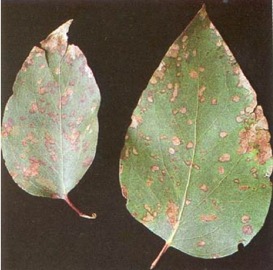PESTS AND DISEASES OF FORESTRY IN NEW ZEALAND
Pseudocercospora Leaf Spots of Eucalyptus
Scion is the leading provider of forest-related knowledge in New Zealand
Formerly known as the Forest Research Institute, Scion has been a leader in research relating to forest health for over 50 years. The Rotorua-based Crown Research Institute continues to provide science that will protect all forests from damage caused by insect pests, pathogens and weeds. The information presented below arises from these research activities.
2. Pseudocercospora Leaf Spots of Eucalyptus,
Forest Pathology in New Zealand No. 1.
Compiled: 1983, minor update 1990
Revised 2009
Fungi
Taxonomic note: Specimens of Pseudocercospora eucalyptorum (previously known as Cercospora eucalypti) on Eucalyptus leaves from the herbarium were examined in 2002 and found to represent four different species. Leaf spots caused by the different fungal species are very similar in appearance.
Pseudocercospora acerosa U. Braun & M. Dick
Pseudocercospora crousii U. Braun & M. Dick
Pseudocercospora eucalyptorum Crous, M.J. Wingfield, Marasas & B. Sutton
Pseudocercospora subulata Z.Q. Yuan, de Little & C. Mohammed
Type of injury
Leaves become disfigured but tree growth is not usually affected. However, heavy infestations may cause premature leaf drop or reduce photosynthesis.

Fig. 2 - Pseudocercospora eucalyptorum on Eucalyptus regnans .
Diagnostic features
Sub-circular to angular-shaped, pale to dark brown spots with a brown to purplish margin which may be somewhat raised. Lesions becoming greyish-brown to grey when old. Found singly or merging together on both the upper and lower surfaces of the leaf. Individual lesions range in size from 1-12 mm in length.
Hosts
Pseudocercospora acerosa: Eucalyptus baxteri, E. nitens, E. verrucata
Pseudocercospora crousii: Eucalyptus dendromorpha, E. fastigata, E. muelleriana, E. pilularis, E. regnans, E. stenostoma
Pseudocercospora eucalyptorum: Eucalyptus botryoides, E delegatensis, E. dendromorpha, E. fastigata, E. fraxinoides, E. globoidea , E. globulus, E. nicholii, E. nitens, E. obliqua, E. ovata, E. radiata, E. regnans, E. resinifera
Pseudocercospora subulata: Eucalyptus nitens
Distribution
Pseudocercospora eucalyptorum is found throughout New Zealand; P. crousii has been recorded from Auckland to Taupo in the North Island and from Mid Canterbury; P. acerosa is found extensively in the South Island and Wanganui in the North Island; P. subulata is known from only one collection in Bay of Plenty.
Disease development
First symptoms have been found on newly-flushed leaves in January. Once the infection is established, a stroma (a conglomeration of fungal filaments) is formed under the epidermis of the leaf. Tufts of filaments bearing spores arise from the stroma and push their way out through the stomatal openings. These threadlike spores are dispersed by wind. The main infection period is from January to March.
Economic importance
There are some records of accelerated leaf fall in Eucalyptus regnans but otherwise these fungi cause little damage.
Control
Not considered necessary.
Bibliography
Braun, U.; Dick, M.A. (2002). Leaf spot diseases of eucalypts in New Zealand caused by Pseudocercospora species. New Zealand Journal of Forestry Science 32(2): 221-234.
Dick, M. 1982: Leaf-inhabiting fungi of eucalypts in New Zealand. New Zealand Journal of Forestry Science 12: 525-537.
Dick, M.; Gadgil, P.D. 1983: Eucalyptus leaf spots. New Zealand Forest Service, Forest Pathology in New Zealand No.1.
This information is intended for general interest only. It is not intended to be a substitute for specific specialist advice on any matter and should not be relied on for that purpose. Scion will not be liable for any direct, indirect, incidental, special, consequential or exemplary damages, loss of profits, or any other intangible losses that result from using the information provided on this site.
(Scion is the trading name of the New Zealand Forest Research Institute Limited.)

 Farm Forestry New Zealand
Farm Forestry New Zealand

